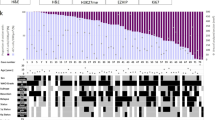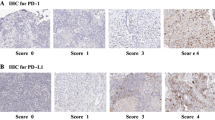Abstract
Immune check-point blockade (ICB) targeting programmed cell death ligand-1 (PD-L1)/programmed death-1 (PD-1) axis has created paradigm shift in cancer treatment. ‘ST-RELA’ and ‘PF-A’ molecular subgroups of ependymomas (EPN) show poor outcomes. We aimed to understand the potential candidature of EPNs for ICB. Supratentorial (ST) Grade II/III EPNs were classified into ST-RELA, ST-YAP, and ST-not otherwise specified (NOS), based on RELA/YAP1 fusion transcripts and/or L1CAM and p65 protein expression. Posterior fossa (PF) EPNs were classified into PF-A and PF-B based on H3K27me3 expression. Immunohistochemistry for PD-L1 and CD8 was performed. RelA protein enrichment at PDL1 promoter site was analysed by chromatin immunoprecipitation-qPCR (ChIP-qPCR). Eighty-three intracranial EPNs were studied. Median tumor infiltrating CD8 + cytotoxic T-lymphocyte (CTL) density was 6/mm2, and was higher in ST-EPNs (median 10/mm2) as compared to PF-EPNs (median 3/mm2). PD-L1 expression was noted in 17/83 (20%) EPNs, including 12/31 ST-RELA and rare ST-NOS (2/12), PF-A (2/25) and PF-B (1/13) EPNs. Twelve EPNs (14%) showed high CTL density and concurrent PD-L1 positivity, of which majority (10/12) were ST-RELA EPNs. Enrichment of RelA protein was seen at PDL1 promoter. Increased CTL densities and upregulation of PD-L1 in ST-RELA ependymomas suggests potential candidature for immunotherapy.




Similar content being viewed by others
References
Ellison DW, McLendon R, Wiestler OD et al (2016) Ependymoma. In: Louis DN, Ohgaki H, Wiestler OD, Cavenee WK (eds) WHO classification of tumours of the central nervous system, 4th edn. IARC, Lyon, pp 106–112
Pajtler KW, Mack SC, Ramaswamy V, Smith CA, Witt H, Smith A et al (2017) The current consensus on the clinical management of intracranial ependymoma and its distinct molecular variants. Acta Neuropathol 133:5–12
Pajtler KW, Witt H, Sill M, Jones DT, Hovestadt V, Kratochwil F et al (2015) Molecular classification of ependymal tumors across all CNS compartments, histopathological grades, and age groups. Cancer Cell 27:728–743
Parker M, Mohankumar KM, Punchihewa C, Weinlich R, Dalton JD, Li Y et al (2014) C11orf95–RELA fusions drive oncogenic NF-κB signalling in ependymoma. Nature 506:451–455
Mack SC, Witt H, Piro RM, Gu L, Zuyderduyn S, Stütz AM et al (2014) Epigenomic alterations define lethal CIMP-positive ependymomas of infancy. Nature 506:445–450
Malgulwar PB, Nambirajan A, Pathak P, Faruq M, Rajeshwari M, Singh M et al (2018) C11orf95-RELA fusions and upregulated NF-KB signalling characterise a subset of aggressive supratentorial ependymomas that express L1CAM and nestin. J Neurooncol 138:29–39
Gessi M, Giagnacovo M, Modena P, Elefante G, Gianno F, Buttarelli FR et al (2019) Role of immunohistochemistry in the identification of supratentorial C11ORF95-RELA fused ependymoma in routine neuropathology. Am J Surg Pathol 43:56–63
Panwalkar P, Clark J, Ramaswamy V, Hawes D, Yang F, Dunham C et al (2017) Immunohistochemical analysis of H3K27me3 demonstrates global reduction in group-A childhood posterior fossa ependymoma and is a powerful predictor of outcome. Acta Neuropathol 134:705–714
Topalian SL, Hodi FS, Brahmer JR, Gettinger SN, Smith DC, McDermott DF et al (2012) Safety, activity, and immune correlates of anti-PD-1 antibody in cancer. N Engl J Med 366:2443–2454
Preusser M, Lim M, Hafler DA, Reardon DA, Sampson JH (2015) Prospects of immune checkpoint modulators in the treatment of glioblastoma. Nat Rev Neurol. 11:504–514
Kong LY, Wei J, Haider AS, Liebelt BD, Ling X, Conrad CA et al (2014) Therapeutic targets in subependymoma. J Neuroimmunol 277:168–175
Dumont B, Forest F, Dal Col P, Karpathiou G, Stephan JL, Vassal F et al (2017) PD1 and PD-L1 in ependymoma might not be therapeutic targets. Clin Neuropathol 36:90–92
Garber ST, Hashimoto Y, Weathers SP, Xiu J, Gatalica Z, Verhaak RG et al (2016) Immune checkpoint blockade as a potential therapeutic target: surveying CNS malignancies. Neuro Oncol 18:1357–1366
Witt DA, Donson AM, Amani V, Moreira DC, Sanford B, Hoffman LM et al (2018) Specific expression of PD-L1 in RELA-fusion supratentorial ependymoma: implications for PD-1-targeted therapy. Pediatr Blood Cancer 65:e26960
Hwang K, Koh EJ, Choi EJ, Kang TH, Han JH, Choe G et al (2018) PD-1/PD-L1 and immune-related gene expression pattern in pediatric malignant brain tumors: clinical correlation with survival data in Korean population. J Neurooncol 139:281–291
Nam SJ, Kim YH, Park JE, Ra YS, Khang SK, Cho YH et al (2019) Tumor-infiltrating immune cell subpopulations and programmed death ligand 1 (PD-L1) expression associated with clinicopathological and prognostic parameters in ependymoma. Cancer Immunol Immunother 68:305–318
Büttner R, Gosney JR, Skov BG, Adam J, Motoi N, Bloom KJ et al (2017) Programmed death-ligand 1 immunohistochemistry testing: a review of analytical assays and clinical implementation in non-small-cell lung cancer. J Clin Oncol 35:3867–3876
Cui S, Dong L, Qian J, Ye L, Jiang L (2018) Classifying non-small cell lung cancer by status of programmed cell death ligand 1 and tumor-infiltrating lymphocytes on tumor cells. J Cancer 9:129–134
Gandini S, Massi D, Mandalà M (2016) PD-L1 expression in cancer patients receiving anti PD-1/PD-L1 antibodies: a systematic review and meta-analysis. Crit Rev Oncol Hematol 100:88–98
Groot JFD, Penas-Prado M, Mandel JJ, O’Brien BJ, Weathers SPS, Zhou S et al (2018) Window of opportunity clinical trial of a PD-1 inhibitor in patients with recurrent glioblastoma. J Clin Oncol 36:2008. https://doi.org/10.1200/JCO.2018.36.15_suppl.2008
Spranger S, Spaapen RM, Zha Y, Williams J, Meng Y, Ha TT et al (2013) Up-regulation of PD-L1, IDO, and T(regs) in the melanoma tumor microenvironment is driven by CD8(+) T cells. Sci Transl Med 5:200ra116
Campesato LF, Barroso-Sousa R, Jimenez L, Correa BR, Sabbaga J, Hoff PM et al (2015) Comprehensive cancer-gene panels can be used to estimate mutational load and predict clinical benefit to PD-1 blockade in clinical practice. Oncotarget 6:34221–34227
Carbone M, Yang H, Gaudino G (2019) Does chromothripsis make mesothelioma an immunogenic cancer? J Thorac Oncol 14:157–159
Koirala P, Roth ME, Gill J, Piperdi S, Chinai JM, Geller DS et al (2016) Immune infiltration and PD-L1 expression in the tumor microenvironment are prognostic in osteosarcoma. Sci Rep 6:30093
Gorsi HS, Malicki DM, Barsan V, Tumblin M, Yeh-Nayre L, Milburn M et al (2019) Nivolumab in the treatment of recurrent or refractory pediatric brain tumors: a single institutional experience. J Pediatr Hematol Oncol 41:e235–e241
Mansfield AS, Peikert T, Smadbeck JB, Udell JBM, Garcia-Rivera E, Elsbernd L et al (2019) Neoantigenic potential of complex chromosomal rearrangements in mesothelioma. J Thorac Oncol 14:276–287
Gowrishankar K, Gunatilake D, Gallagher SJ, Tiffen J, Rizos H, Hersey P (2015) Inducible but not constitutive expression of PD-L1 in human melanoma cells is dependent on activation of NF-κB. PLoS One 10:e0123410
Fang W, Zhang J, Hong S, Zhan J, Chen N, Qin T et al (2014) EBV-driven LMP1 and IFN-γ up-regulate PD-L1 in nasopharyngeal carcinoma: implications for oncotargeted therapy. Oncotarget 5:12189–12202
Asgarova A, Asgarov K, Godet Y, Peixoto P, Nadaradjane A, Boyer-Guittaut M et al (2018) PD-L1 expression is regulated by both DNA methylation and NF-kB during EMT signaling in non-small cell lung carcinoma. Oncoimmunology 7:e1423170
Malgulwar PB, Nambirajan A, Pathak P, Rajeshwari M, Suri V, Sarkar C et al (2018) Epithelial-to-mesenchymal transition–related transcription factors are up-regulated in ependymomas and correlate with a poor prognosis. Hum Pathol 82:149–157
Donson AM, Birks DK, Barton VN, Wei Q, Kleinschmidt-Demasters BK, Handler MH et al (2009) Immune gene and cell enrichment is associated with a good prognosis in ependymoma. J Immunol 183:7428–7440
Hoffman LM, Donson AM, Nakachi I, Griesinger AM, Birks DK, Amani V et al (2014) Molecular sub-group-specific immunophenotypic changes are associated with outcome in recurrent posterior fossa ependymoma. Acta Neuropathol 127:731–745
Griesinger AM, Josephson RJ, Donson AM, Mulcahy Levy JM, Amani V, Birks DK et al (2015) Interleukin-6/STAT3 pathway signaling drives an inflammatory phenotype in Group A ependymoma. Cancer Immunol Res 3:1165–1174
Griesinger AM, Birks DK, Donson AM, Amani V, Hoffman LM, Waziri A et al (2013) Characterization of distinct immunophenotypes across pediatric brain tumor types. J Immunol 191:4880–4888
Xue S, Song G, Yu J (2017) The prognostic significance of PD-L1 expression in patients with glioma: a meta-analysis. Sci Rep 7:4231
Wang Y, Zhu C, Song W, Li J, Zhao G, Cao H (2018) PD-L1 expression and CD8(+) T cell infiltration predict a favorable prognosis in advanced gastric cancer. J Immunol Res 2018:4180517
Funding
This work is supported by the Science and Engineering Research Board (SERB) (EMR/2016/003365), New Delhi, India; Central Institute of Industrial research (CSIR), New Delhi, India (Pool No 8948A/17); and Neurosciences centre, AIIMS, New Delhi (intramural grants).
Author information
Authors and Affiliations
Contributions
NA: conceptualization, methodology, formal analysis, data curation, writing—original draft, and writing—review and editing; MPB: methodology, data curation, formal analysis, writing—review and editing; SA: data curation, writing—review and editing; BM: data curation, writing—review and editing; SM: data curation, writing—review and editing; SV: data curation, writing—review and editing; SC: data curation, writing—review and editing; SMC: conceptualization, methodology, funding acquisition, project administration, formal analysis, data curation, writing—original draft, and writing—review and editing
Corresponding author
Ethics declarations
Conflict of interest
All authors declare no conflicts of interest.
Ethical approval
The research has been ethically approved by the institute ethics committee (Ref. No. IEC-602/03.11.2017)
Additional information
Publisher's Note
Springer Nature remains neutral with regard to jurisdictional claims in published maps and institutional affiliations.
Electronic supplementary material
Below is the link to the electronic supplementary material.
Rights and permissions
About this article
Cite this article
Nambirajan, A., Malgulwar, P.B., Sharma, A. et al. Clinicopathological evaluation of PD-L1 expression and cytotoxic T-lymphocyte infiltrates across intracranial molecular subgroups of ependymomas: are these tumors potential candidates for immune check-point blockade?. Brain Tumor Pathol 36, 152–161 (2019). https://doi.org/10.1007/s10014-019-00350-1
Received:
Accepted:
Published:
Issue Date:
DOI: https://doi.org/10.1007/s10014-019-00350-1




